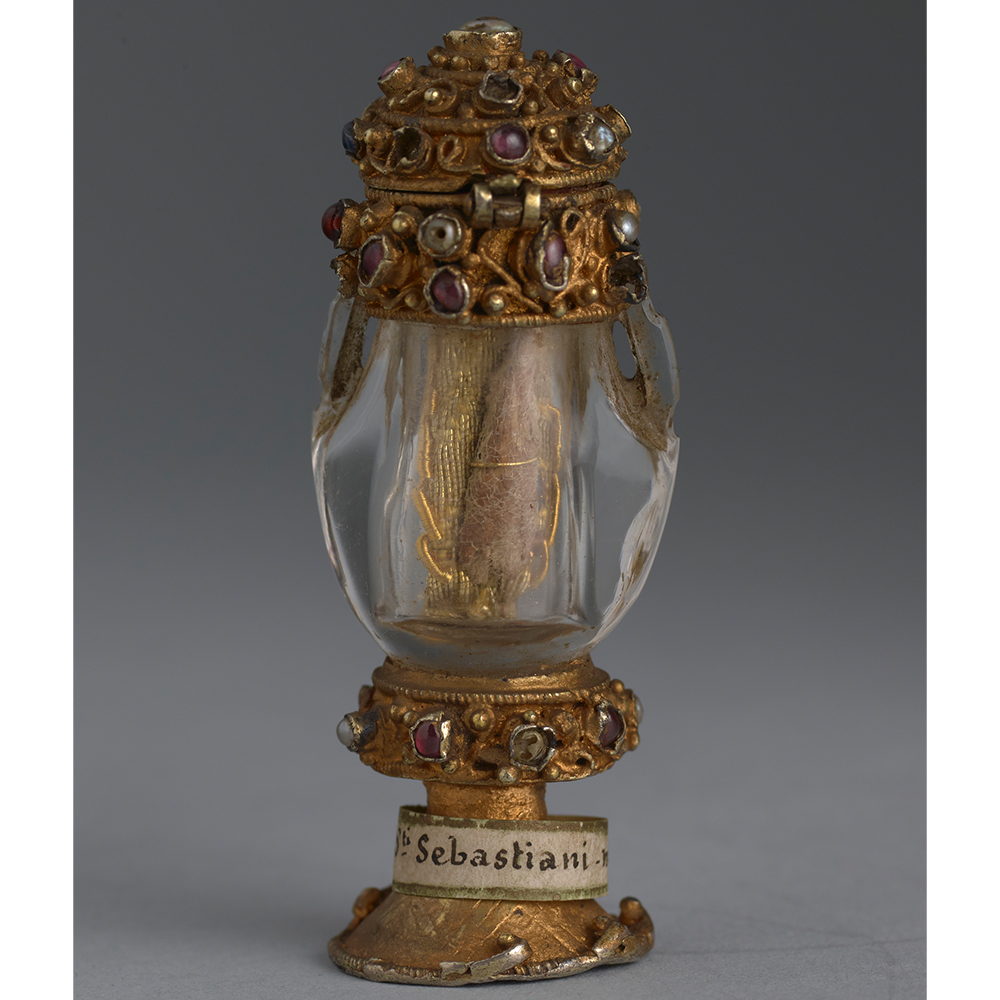Reliquary with Rock-Crystal Vessel

c.1200–1230 (vessel might be earlier)
Present-day Belgium, France, Germany, or Netherlands
Rock crystal, gold, gems
Height: 2.6 in (6.5 cm)
Wyvern Collection, 0968
This reliquary holds a bone fragment purportedly belonging to Saint Sebastian, within a central rock-crystal vessel. Reliquaries—containers constructed to hold relics, typically the bones of saints or reverential objects connected to the Passion of Christ—were made in great numbers throughout the medieval period in Europe. These repositories are often elaborately and lavishly ornamented to reflect the spiritual richness of the relics held within. Perhaps originally placed inside an altar or a tabernacle, this particular reliquary is decorated above and below the bone fragment with a plethora of colorful gems resting in the delicate metal setting that forms a base and lid for the reliquary. Its diminutive size encouraged intimate engagement and personal contemplation of Christian symbolism prompted by the rock-crystal core.
Rock crystal lends itself well to a variety of possible Christian interpretations, in addition to serving the practical purpose of rendering the relic visible, even magnifying it at times. The range of medieval Christian associations with this material is scripturally rooted in the Book of Revelation (22:1): “And he showed me a pure river of water of life, clear as crystal, proceeding out of the throne of God and of the Lamb,” and for a Christian viewer, the image of a clear flowing river would call to mind the baptismal waters of salvation. (1) Additionally, rock crystal, transparent yet seemingly unbreakable, was understood in the Middle Ages as petrified water. The transition from a liquid to a solid state signified the transformation of Christ’s penetrable body to its immaculate, everlasting form achieved through the Resurrection. At the same time, the possibility of oscillating between flowing water and its solidified form inspired a sense of hope for sinfully hardened souls to return to the light of God through conversion and reformation. (2) The multiple medieval Christian interpretations honor the miraculous nature of God and are reinforced by the relic’s visibility within this ideologically charged rock crystal.
Although the clear quartz creates opportunities for medieval Christian readings, the tiny hollow vessel might have been a late-Roman or Byzantine perfume bottle. Medieval refashioning of an antique object suggests how the present may reign supreme over the past. Delicate vessels designed to hold fragrant oils were commonly produced in the Roman Empire as a means of expressing one’s societal rank. (3) In the case of this reliquary, if the small bottle was understood in the thirteenth century to be from the Roman period, the decision to appropriate it here would have demonstrated the triumph of Christianity over pagan Roman culture. The medieval recasting of a perfume bottle to create a reliquary was similarly executed elsewhere, exemplified by the small Fatimid flask housed at the British Museum. (4) Unlike the Fatimid Flask Reliquary’s narrow cylindrical form, the perfume bottle in the Wyvern reliquary takes the shape of a Roman amphora with its wide body and two delicate, narrow handles. While the Wyvern reliquary might reflect the pagan past, the Fatimid Flask Reliquary’s rock-crystal piece is elaborately carved with an Arabic inscription. By appropriating and refashioning these antique objects, medieval Christian owners sought to assert Christianity’s triumph over other faiths.
Brooke Wrubel, Class of 2021
Notes
- Bagnoli et al. 2010; Robinson et al. 2014.
- Bagnoli et al. 2010; Gerevini 2014.
- 3. Brun 2000, p. 277.
- London, British Museum, AF.3129; Robinson et al. 2010.